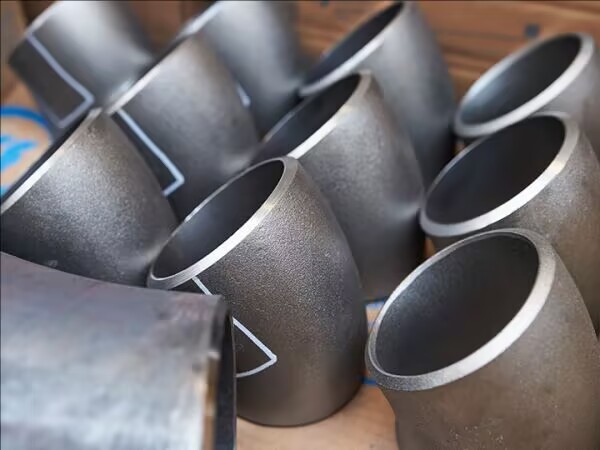Carbon steel welded pipe fittings are connection parts made of carbon steel as the base material through welding methods such as butt welding and socket welding, and are widely used in fields such as petrochemicals, chemical engineering, power, water treatment and HVAC.
Carbon steel pipe fittings have excellent pressure resistance and good mechanical strength. The carbon content is generally between 0.06% and 1.5%, and they can operate reliably for a long time in high-temperature and high-pressure environments. Its main advantages are low cost, easy processing and convenient installation. However, at the same time, it has high requirements for welding technology and quality control, and it is necessary to strictly follow the corresponding standards, and implement surface anti-corrosion treatment and regular inspection and maintenance.

Common standard:
ASTM A234 WPB is a commonly used international standard for carbon steel butt-weld pipe fittings, covering butt-weld elbows, tees, reducers, etc., and is suitable for medium and high-temperature pressure pipelines.
Material grades can be classified into low carbon steel, medium carbon steel and high carbon steel.
Low carbon steel (C≤0.25%) : It has good plasticity and weldability, the lowest cost, and is suitable for medium and low pressure pipelines.
Medium carbon steel (0.25%<C≤0.60%) : It has relatively high strength and hardness and can be used in situations requiring higher strength, but the heat input for welding and preheating conditions need to be controlled.
High-carbon steel (C>0.60%) : It is generally less used in the manufacturing of pipe fittings because of its poor weldability and the need for strict heat treatment processes.
The main product types of carbon steel welded pipe fittings
Elbow: It changes the direction of the pipe and can be divided into various forms such as long radius, short radius, 45°/90°/180°, etc.
Tee: A three-way branch or convergence, which is divided into equal-path tee and different-path tee.
Reducer: It is used for transitional connections between different pipe diameters and has two structures: concentric and eccentric.
Butt-weld flanges (Weld Neck, Slip-On, Socket Weld, etc.) : Connected to equipment or other pipes, with various interface forms, and need to be used in conjunction with corresponding standards and sealing gaskets.
Raw materials and forming: Large-diameter pipe fittings can be formed by hot-rolling steel plates and then welded. Medium and small diameter pipe fittings are usually made from seamless or welded steel pipes as raw materials, processed into shape and then welded into shape.
Common welding processes include:
Root Pass welding: Manual argon arc welding or submerged arc automatic welding is adopted to ensure that the root penetration depth and width of the weld seam meet the requirements of the drawing.
Fill & Cap Pass welding: Cored wires or solid wires protected by CO₂ gas are commonly used, and the gas ratio is mostly 80%Ar+20%CO₂ to control the temperature of the molten pool, reduce post-weld deformation and improve the weld formation.
Preheating and interlayer temperature control: Medium carbon steel needs to be preheated to 100-200℃ according to its thickness, and the interlayer temperature should be maintained between 150-250℃ to prevent crack formation.
Post-heat treatment: Stress relief heat treatment is carried out on high-carbon or thick-walled pipe fittings to enhance the toughness of the weld seam and heat-affected zone.
Welding technology and quality control
Non-destructive testing (NDT)
Radiographic testing (RT) : It was widely used in the early days, is intuitive and reliable, and can be archived. It is suitable for detecting internal defects at the root of pipes and filling welds.
Ultrasonic testing (UT/PAUT) : It can achieve on-site online inspection, has a high coverage rate, and is suitable for the quality assessment of thick-walled pipe fittings and welds. It has gradually replaced some RT applications.
Magnetic particle testing (MT) and penetrant testing (PT) : These are used for surface and near-surface defect detection. They are easy to operate but are greatly affected by the surface condition of the workpiece.
Pressure testing and mechanical property inspection
Hydraulic/pneumatic test: Conduct a hydraulic test at 1.5 times the design pressure to verify the sealing performance and pressure-bearing capacity of the pipe fittings and welds.
Metallographic inspection and mechanical property tests: Microstructure examination and tensile and impact tests are conducted on typical welds to ensure that the mechanical properties of the welded joints meet the standards.
Application field
Carbon steel welded pipe fittings are widely used in: Due to their high strength, reliability and economy
Oil and gas transmission pipelines and branch systems.
Pipeline network of chemical and oil refining facilities.
Thermal power plants and nuclear power plants, high-temperature and high-pressure boiler piping systems.
Municipal water supply, drainage and HVAC systems.
